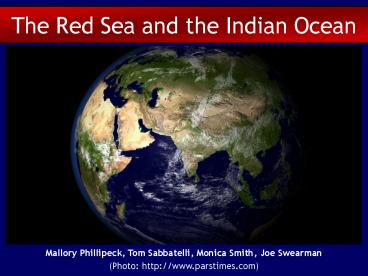The Red Sea and the Indian Ocean - PowerPoint PPT Presentation
1 / 17
Title:
The Red Sea and the Indian Ocean
Description:
The Red Sea and the Indian Ocean. Mallory Phillipeck, Tom Sabbatelli, Monica Smith, Joe Swearman ... water flows into the southern Red Sea via the Gulf of Aden ... – PowerPoint PPT presentation
Number of Views:211
Avg rating:3.0/5.0
Title: The Red Sea and the Indian Ocean
1
The Red Sea and the Indian Ocean
Mallory Phillipeck, Tom Sabbatelli, Monica Smith,
Joe Swearman
(Photo http//www.parstimes.com)
2
Preview
Review Ideal Coral Reef Conditions
Joe and Tom Analysis of Aquatic Conditions
Indian Ocean
Red Sea
Monica and Mallory Distribution,
diversity/uniqueness
3
The Red Sea
4
Red Sea Coral Reefs
Nearly 220 recorded coral species exist in a
surprisingly diverse area
Total reef area less than 50 km2
Extremely small area considering the seas
surface area is between 438,000 and 450,000 km2
(Photo http//www.tropicalevergreens.com)
5
Red Sea Cross Section
6
Red Sea Cross Section
7
Temperature Variability
8
Temperature Variability
As evidenced by the maps, the Red Sea waters
display great temperature variability between
seasons
In the winter, temperatures can vary from 18C in
the north to 28C to the south
In the summer months, some regions can see
temperatures in excess of 31C
9
Salinity
40.5
40
36.5
10
Why is the Red Sea so salty?
Red Sea waters are the saltiest of any of the
worlds oceans
No rivers flow into the sea, therefore no fresh
water deposit
(Photo http//www.wikipedia.org)
Surrounding environment is very sunny and windy,
driving a lot of evaporation
Absence of rivers also explains low amount of
sediment in the sea
11
Best Diving Anywhere
Due to its very low sediment levels, the Red Sea
is one of the best and clearest diving sites in
the world
(All photos www.bluzone.com)
12
Best Diving Anywhere
13
Red Sea Currents
Red Sea currents are known for their weak
strength and their variability
In summer, northerly winds flow to the SSE with
the South-West Monsoon
Flow reverses in winter as the North-East Monsoon
draws a surface flow into the Red Sea
14
Red Sea Nutrients
Nutrient-rich water flows into the southern Red
Sea via the Gulf of Aden
Flow strongest from July to September
However, nutrient levels are still relatively low
Red Sea Euphotic ((µmol)
Southern
Central
Northern
Phosphate
0.1-0.3
0.05-0.1
0.01-0.05
Nitrate
0.03-0.2
0.03-0.2
0.1-0.4
Silicate
0.4-0.7
0.3-0.6
0.2-0.4
15
How do corals survive?
Red Sea corals face a number of survival
obstacles extreme temperature variability, high
salinity, and very low nutrient levels
Seems that over time, corals have adapted to the
harsh conditions and are able to thrive
Encouraging news to scientists, possibly hinting
that corals can thrive in relatively extreme
water temperatures
Sponges embedded in coral communities provide
nutrients to coral (more later)
16
Indian Ocean Distribution
Indian Ocean not a well mixed basin
One-third of coral species are very widespread
and one-third restricted to less than 3 or 4
sites
Decline in diversity north and south, but richer
fauna in the east and west
(Photo http//dspace.dial.pipex.com)
17
Red Sea Distribution
Strong north-south gradients with best developed
reefs in northern and central regions
Can be divided along latitudinal lines (north,
central, south)
Southern Red Sea poor in reefs favoring algal
growth over coral development
(Photo http//usinfo.state.gov)































